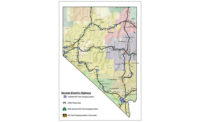California Energy Commission OKs $1.9B for EV Charging Stations

California intends to create the nation's largest EV charging network.
Photo courtesy of CEC
The California Energy Commission on Feb. 14 approved $1.9 billion to expand the state’s network of charging and refueling infrastructure for zero-emission cars, trucks and buses, set to create the most extensive charging and hydrogen refueling network in the country, say officials.
The state funding comes from its Clean Transportation Program and will be spent over the next four years, with at least 50% targeted to benefit priority populations. Part of the $48 billion California Climate Commitment, itincludes more than $10 billion for zero-emission vehicles and infrastructure.
“We need to make sure that this is zero emission refueling infrastructure for everybody,” said lead agency commissioner for Transportation Patty Monahan in a statement. “By investing a bulk of funds to benefit low-income and disadvantaged communities, the state is making sure communities most in need have better access to chargers and less pollution from trucks and buses.”
In 2023, 25% of new cars sold in California were zero-emission. Officials say this new funding will create 40,000 new chargers statewide, adding to nearly 94,000 public and shared private chargers currently installed in the state. Combined with previous funding, the state hopes to reach a goal of 250,000 chargers in the next few years. This is in addition to private installations and home chargers.
The $1.9 billion will become available over the next four years and distributed to projects through competitive grants. Funds include direct incentive and rebate programs for businesses, non-profit organizations, tribes and public agencies.
The Clean Transportation Program created in 2007, is one of the first transportation-focused funding efforts established to help advance state climate change policies. It is funded by vehicle and vessel registration, vehicle identification plates and smog abatement fees. To date, $1.8 billion has been invested in projects supporting zero-emission vehicle infrastructure, alternative fuels and advanced vehicle technologies. This includes nearly 24,500 EV chargers installed or planned and funding for 96 public hydrogen fueling stations, of which 61 are open today.
The program also offers streamlined incentives for EV chargers, awarded $100 million to 120 projects for truck and bus charging and refueling and provided funding to California public school districts for electric school bus charging.
The commission also approved the second Assembly Bill 2127 Electric Vehicle Charging Infrastructure Assessment that projects how much publicly available charging infrastructure is needed to meet demand. Results show that in 2030, 7.1 million EVs will need 1 million chargers and 155,000 electric trucks and buses will need 114,500 chargers.
Funding should help lay groundwork for the West Coast Clean Transit Corridor Initiative, an ongoing, collaborative effort among 16 utilities in California, Oregon, Washington and British Columbia to support development of electric vehicle charging facilities along 1,300 miles of Interstate-5, for heavy- and medium-duty freight haulers and delivery trucks.
Utilities are conducting grid readiness assessments in preparation for infrastructure installations and upgrades to support vehicle charging capacities of at least 3.5 MW, with potential added upgrades to create higher-capacity sites.
Utilities involved in the initiative are San Diego Gas & Electric, Southern California Edison, Southern California Public Power Authority, Los Angeles Dept. of Water & Power, Pacific Gas and Electric Co., Northern California Power Agency, City of Redding, Sacramento Municipal Utility District, Pacific Power, Portland General Electric, Clark Public Utilities, Cowlitz County PUD, Lewis County PUD, Tacoma Public Utilities, Seattle City Light, Puget Sound Energy, Snohomish PUD and BC Hydro.




